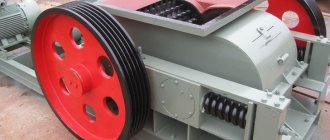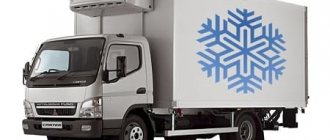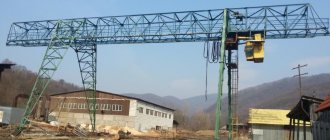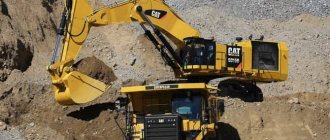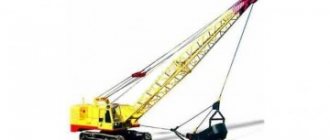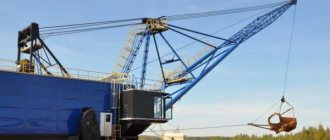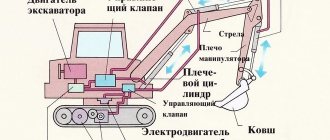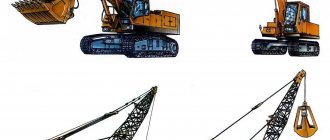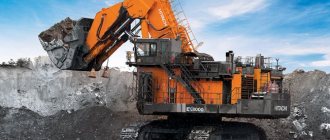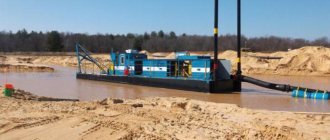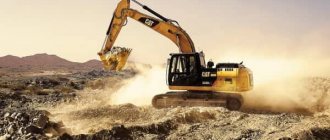A bucket wheel excavator is a machine that is used in a large number of fields today. There is a growing demand for this installation due to the large number of advantages that the design has. Today we will tell you not only about the areas of application and advantages of this device, but also consider the classification of units and show photographs of the largest of them.
Classification of machines and units
Multi-bucket excavators differ in design and technical capabilities. Depending on the functions they perform, they can be stripping or mining. Both the first and second ones carry out the development of the soil. Based on the direction of the working field, they are divided into longitudinal or radial digging models. In areas of varying complexity, the methods of approaching the buckets to the soil may change: rock is removed, the earth is removed using upper or lower scooping.
There are special trench type rotors:
- plow-rotor, moving in one direction;
- high-speed trench complex for military purposes;
- screw-rotor.
For open-pit mining, the ideal option is a rotary (quarry) excavator.
According to the method of movement, they are combined into two large groups: self-propelled (on tracks and rails) or mounted (attached to a tractor-tractor).
Unit characteristics
Rotary excavators and their design include characteristics that act as decisive factors when choosing this machine for excavation work in quarries and other areas of mining.
Let's highlight several important characteristics:
- The diameter of each wheel of the structure. They reach a diameter of up to 18 meters.
- Capacity of buckets in the apparatus. Each of them is capable of holding 1600 liters of resources.
- Approximate performance indicator. The buckets of the bucket wheel excavator are capable of delivering 10,000 m³/h in productivity.
- The height at which development occurs. The device is capable of working productively at heights of up to 33 meters.
- The depth to which the buckets go. The maximum depth at which medium-sized units can operate reaches 5 meters.
These are the main characteristics of machines that are increasingly used in large mining and mineral development projects.
It is important that the performance indicators of bucket wheel excavators may vary depending on specific models and brands.
Applications and performance
A rotary trench excavator is in demand in the construction of gas pipelines, sewer and collector communications, when laying underground communication systems over kilometer distances, and when digging shallow pits. It is convenient for them to carry out excavations during excavations or large-scale repairs and rescue operations.
An open sand or clay quarry and a bucket wheel excavator cannot be thought of separately. The machine is capable of extracting and shipping bulk solids at a height of up to 25 m and at a depth of 5 meters. They are also used in the direct development of coal faces, when it is necessary to open the soil layer, ship finished products or dump rock.
The main common feature of all excavators of this type is the possibility of uninterrupted round-the-clock operation with high productivity rates, and use in hard-to-reach areas. Climatic conditions, increase or decrease in temperature do not affect quality. Such a cycle is beneficial for the extraction of ore minerals and natural building materials. Save money; thanks to the design of the buckets, losses during loading are minimized.
Scope of application of trench excavators
The purpose of trench excavators is to prepare holes, ditches and trenches of certain sizes and shapes for the construction of various residential, industrial or road transport facilities. They are used in the construction of the following facilities:
- Underground communications for various purposes by open trenching:
- Pipelines for transporting water, gas, oil, etc.,
- Centralized heating systems,
- Sewage systems,
- Cable communication lines or power supply.
- Long strip foundations for the installation of various buildings and structures,
- To create smooth contours for future pits and other construction excavations.
INTERESTING! Trenchers, unlike single-bucket excavators, are capable of developing absolutely any type of soil, even frozen and rocky.
Similarities and differences between designs
The operating principle and design of rotary excavators are the same for most mechanisms. They represent a single system and consist of a rotating platform to which important components are attached: the chassis, a cabin with a control panel, a superstructure with masts, a moldboard and rotary boom with a conveyor belt.
The difference is significant only in:
- the number of buckets, the diameter of the circle to which they are attached;
- boom length;
- placement of the superstructure;
- the footage of the blade, its rotations and the tonnage of the counterweight;
- engine power;
- methods of unloading buckets (from centrifugal force or from gravity) and in movement.
There are minor differences between the modifications, expressed in bucket capacity, depth, and digging height. They affect how the units are used.
Advantages of using such units
Let us highlight several objective advantages due to which a growing number of large mining enterprises are choosing such machines:
- High level of productivity. It reaches more than 10,000 m³/h.
- Reliability of the entire structure. It rarely breaks and can be repaired on site.
- Ability to work in different climates. The installation can stably perform its task both in hot weather and in severe frost. This factor expands the scope of application of the devices.
- Carrying out work at different heights. You can drip at a height that exceeds the level of the installation itself, or is below it.
- Arrow length. This allows him to work in a stationary position.
- Length of continuous work. The installation can operate without stopping for several days.
This is just a starting list of positive traits, but they come at a high cost.
Technical parameters of the units
The characteristics of types and models differ in digital indicators. You can take average or specific numbers as a basis, but each type is equipped with a telescopic (folding) or stationary boom, at the end of which a rotor rotates. Its position is secured using a winch and cables passed between pulley blocks on the masts. On the opposite side there is a similar dump boom. The mechanism for lowering and raising them follows the same pattern; the hovering angle is regulated by counterweights. These parts together form a superstructure that can rotate around its axis by 360°. This significantly expands production possibilities. The unloading unit (conveyor) has an autonomous rotary mechanics with a deflection angle of 270°, which simplifies the laying of access roads for transport. The operating principle of quarry and trench units is almost identical.
The world's monster bucket wheel excavators
A large mining machine operates in Germany near Cologne at the Hambach mine. Bagger 288 has a height of 94 meters and a length of 220 m. A huge wheel with a diameter of 32 m weighs 13,500 tons, and is mounted on a 60-meter boom. The productivity of the giant rotary excavator is 245 thousand m 3 per day. Capable of digging coal from a depth of 100 m. Moves along the surface on 12 tracks. Their dimensions (height 3, width 3.5, length 15 meters) are calculated in accordance with the total weight.
The miracle of technology is maintained by a team of 5 people. Work on one field continues as long as it is feasible and profitable. The main difficulty is to maintain the balance of the rotor and the correct direction when moving to avoid swinging. In addition, it is very important to choose a flat surface.
The Bagger 293 can compete with its relative. It was built in 1995 for the formation of quarries and operates continuously for 3–5 days. Included in the Book of Records as the owner of the largest mechanism.
People never cease to be amazed at how it works. It turns out that you just need to follow safety rules and have engineering knowledge, and servicing such units will not be difficult.
The advantages of using it are obvious. A long service life (60–70 years), enormous volumes of work and the number of functions performed quickly pay for the costs of construction and technical support.
Excavator ETR-254 (basic model) is designed for developing trenches for main pipelines with a diameter of 1220, 1420 and 1620 mm at a digging depth of 2.5 m (720, 920 and 1020 mm at a depth of 2.5 m - for ETR-254-01; 1220 and 1420 at a depth of 3 m - for ETR-254-02). The main design differences between the ETR-254-01 excavator and the ETR-254 are as follows: smaller rotor width with a single-row arrangement of buckets; single rear support wheel; single-speed helical gearbox of the conveyor drive. The tractor, the linkage system and the connection between the tractor and the working element, as well as a number of components of the working element are completely unified with the same components of the ETR-254 excavator. The base of the excavators is a special tractor, the design of which uses all the main and transmission components of the K-701 tractor and the chassis components of the T-130 tractor. The travel drive is mechanical, with hydraulic gear shifting; the rotor and conveyor drive is mechanical, the lifting of the working parts is hydraulic; drive engine - YaMZ-240B (YaMZ-240BM) with a power of 300 hp; excavators have 32 working speeds (from 20 to 509 m/h). Prototypes of the ETR-254-01 excavator were tested on the construction of a gas pipeline in the area between Urengoy and Nadym, where they showed good results and their serial production began in 1982. In the winter season of 1982-1983, an installation batch of ETR-254-01 excavators completed a large amount of work in the Urengoy gas fields, and ten of the same machines from February to April 1983 dug about 240 km of freezing trenches in frozen and permafrost soils to full depth!Excavator ETR-254-05 has a device for soil reclamation - two additional rotors (2), installed on both sides of the main rotor (1). With one pass along the axis of the trench, a rotary reclaimer removes the fertile soil layer from a strip 3.5 m wide. For this, ETR 254-05 excavator conveyors, which have a hydraulic suspension, are equipped with a device that increases the soil transportation range to a distance of 11-13 m from the edge of the reclamation strip to the middle of the dump.
To implement slot technologies for developing trenches in permafrost soils, in the 80s, attempts were made in the pipeline construction industry to create a slot cutter with a digging depth of 2.5 m. The experience of using domestic rotary excavators of medium and high power for developing trenches in permafrost showed high efficiency due to the method cutting soils “large chip”, but only with a specific power of 200 hp. and more per square meter of the cross-sectional area of the trench. With a specific power of less than 100 hp/m2, the process of cutting MMG turns into a process of wear of teeth on emery.
| Photo 1. A prototype of a slot cutter with a bucketless working body | Photo 2. Bucket cutter ETR-254-06 in operation |
Tests of two prototypes showed the inability of bucketless working bodies to lift soil from a depth of more than 1.5 m (photo 1). After an unsuccessful attempt to create a bucketless slot cutter, VNIIST got the opportunity to implement a slot cutter project with a bucket (rotary) working body that implements the “large chip” principle of cutting soil. A prototype of a slot cutter with a digging depth of 3 m and a working body width of 0.5 m was created as a replacement working tool for the serial rotary excavator ETR-254-01 (photo 2). The working body is equipped with a wheel support in the transport position. In the working position, the working element rests on a rigid support, and the wheel support moves along the berm of the trench. The rotor drive is mechanical, interchangeable with ETR-254-01, the conveyor drive is hydraulic. Acceptance tests were carried out at the Yamburgskoye field. The ability to develop durable MMGs with a speed of 80-100 m/h was confirmed. Based on the results of acceptance tests, the slot cutter was included in the industry catalog of pipeline construction equipment under the index ETR-254-06 .
Technical characteristics of rotary excavators of the ETR-254 family
| Name of parameters | ||||
| ETR-254 | ETR-254-01 | ETR-254-02 | ETR-254-05 | |
| Dimensions of the trench to be torn off, m: | ||||
| depth/width | 2,5 / 1,8; 2,1 | 2,5 / 1,2; 1,5 | 3,0 / 2,1 | 2,5 / 3,5 |
| Engine power, kW | 220 | 220 | 220 | 220 |
| Technical productivity, m3/h , in category I soils | 1200 | 900 | 1200 | 1200 |
| Range of soil movement to the dump, m | 5 | 5 | 5 | 5 — 14 |
| Working speed, m/h | — | 20-509 (32 speeds) | — | — |
| Transport speed, km/h | — | 0,48 — 5,6 | 0,48 — 5,6 | 0,48 — 5,6 |
| Overall dimensions, mm: length x width x height | 13500 x 4200 x 4350 | 13500 x 4200 x 4350 | 13500 x 4200 x 5200 | 13500 x 4200 x 4350 |
| Weight, kg | 41000 | 36000 | 43000 | 45000 |
| Specific ground pressure, MPa | 0,067 | 0,063 | 0,069 | 0,071 |
ETR-254A excavator is a modernization of the ETR-254 excavator. The tractor and the working part of the excavator were modernized. The modernization of the tractor included lengthening the caterpillar track, reducing the overhang of the power unit and cab, and lowering the tension and drive wheels. The rear axle has been strengthened and ergonomic characteristics have been improved. A reduced operating speed has been introduced for more stable operation of the excavator on particularly strong soils. When modernizing the working body, the strength of the rotor buckets, the durability of the rack and pinion gearing, support and guide rollers, the chain drive, and the reliability of the conveyor drive were increased. The energy consumption of digging has been reduced by improving the arrangement of the teeth of the rotor buckets. The designs of the limiting torque clutch and the rotor reverse gear have been changed, which provide more reliable protection of the transmission from overloads.
The design of the excavators was developed by SKB "Gazstroymashina" according to the initial requirements of VNIIST and Glavtruboprovodstroy; were produced by the Moscow Experimental Mechanical Plant (MEMZ) of the Ministry of Oil and Gas Construction at the request of central administrations and associations.
Features of bucket wheel excavators
All excavators available on the special equipment market are divided into single-bucket and multi-bucket models. The former are mainly used on construction sites. They belong to machines of one cycle, that is, they perform a certain amount of work per unit of time.
The latter are used in the mining industry, mineral development, and the extraction of sand from quarries. They belong to the continuous operation technology, and accordingly have greater productivity compared to single-bucket models. Continuous earthmoving equipment is divided into rotary and chain action machines. Consider a bucket wheel excavator.
Rotary trench excavators
Was:
single-bucket construction excavators. Classification. Excavators with working equipment: crane, grab, front and backhoes; dragline. Excavators with hydraulic drive. Hydraulic and hydropneumatic hammers. Partial rotation hydraulic universal excavators. Small-sized mini- and microexcavators. Excavator-planners.
CONTINUOUS EXCAVATORS
Continuous excavators are earth-moving machines that continuously excavate soil while simultaneously loading it into a vehicle or placing it in a dump. The working body of a continuous excavator is equipped with several buckets, scrapers or cutters that alternately separate the soil from the massif. They are mounted on a single working body - a rotor or a closed circuit, positioned with a certain constant pitch.
The soil is developed in a process of two independent movements:
relative - repeated continuous movement of buckets or working bodies replacing them along a closed path relative to the supporting frame and portable - movement of the frame together with the working bodies, called feed. To dump soil, a special transport device is used, more often a belt conveyor, onto which the soil is supplied from buckets or working parts that replace them.
The uniformity of working movements predetermines the automation of the process and, as a result, ease of control, which comes down to the initial setting of the excavator to a certain mode in accordance with the technological requirements and characteristics of the soil being developed, monitoring its operation and operational manual control in extreme situations, for example, to stop a worker organ when encountering an insurmountable obstacle, to change the modes of working movements, etc. According to this indicator, continuous excavators have an advantage over single-bucket excavators, the management of the work process of which requires the constant participation of the operator during each excavation cycle. The second important advantage of these excavators over single-bucket ones is the more complete use of the installed power of the power plant over time and, as a consequence, other things being equal, higher technical productivity.
Classify
continuous excavators (Fig. 138) according to the following characteristics.
Fig. 138. Types of continuous excavators: A — rotary trench; |
By purpose
or type of work performed: trench - for digging and filling trenches;
quarry - for the extraction of building materials in quarries;
construction and quarry - for mass excavation work in construction.
By type of working body
: rotary and chain.
By digging method
: longitudinal, when relative and portable movement occurs in the same plane, and transverse digging - otherwise.
The remaining classification features are common to construction machines ( by type of drive, running gear, etc.
.).
Trench excavators are continuous earth-moving machines with a longitudinal digging working body, used for digging trenches - excavations of great length compared to the size of their cross sections.
Depending on the type of working body, rotary
and chain trench excavators
.
In a rotary excavator, the buckets are placed with equal spacing along the periphery of the working body - the rotor, and in chain excavators - on a closed bucket chain. Rotary excavators are used to develop trenches of limited depth (up to 3 m
) due to the fact that a further increase in this parameter requires an increase in the diameter of the rotor and the associated overall height, the limit values of which are regulated by the conditions for the safe movement of the excavator when it is relocated to a new construction site under bridges, overpasses, power lines, etc. The chain working parts, when transferred to the transport position, are located almost horizontally without increasing the overall height.
Therefore, chain excavators can excavate trenches of any practical depth. The domestic industry produces chain excavators for developing trenches up to 6 m
.
Trench excavators are effectively used to develop homogeneous soils up to category IV inclusive. Large rocky inclusions reduce the service life of these machines, lead to frequent failures, downtime and additional costs for repair and restoration work. Special rotary trench excavators are also capable of developing frozen soils.
Being a continuous-action machine, a trench excavator most fully realizes its technological capabilities when developing long-distance trenches with the smallest possible number of pioneer excavations for introducing the working body into the trench, which are usually completed to a full profile with single-bucket excavators.
The main parameter of a trench excavator is the depth of the trench being torn off, which is included in its index. For example, ETR-254 designates a rotary trench excavator of the fourth model for developing trenches up to 2.5 m
;
ETC-165 is a chain trench excavator of the fifth model, trench depth up to 1.6 m
. The main parameters are the weight of the excavator and engine power.
A trench excavator consists of a tractor and working equipment connected to each other using a semi-trailer (most rotary excavators) or mounted (small models of rotary excavators and their lightweight modifications, chain excavators) schemes.
Tracked or wheeled tractors with the necessary modifications are usually used as base tractors for small models of trench excavators. Tractor units of medium and heavy excavator models are made mainly from tractor units and parts, while maintaining the basic design of a tractor propulsion system, but in comparison with basic tractors, widening the track and lengthening the base. Together with wide shoes, this achieves a reduction in ground pressure (50...80 kPa
), which allows these machines to work in soils with reduced bearing capacity.
The working equipment of the trench excavator ensures that the soil in the trench of the designed depth and width is separated from the mass with or without slopes, is completely removed from the trench and dumped into a parapet (cavalier) next to the trench. The latter operation is usually performed by a blade conveyor belt mounted perpendicular to the longitudinal axis of the trench either in the rotor cavity (on bucket wheel excavators) or on a tractor (on chain excavators). To develop narrow trenches (cracks), non-conveyor scraper and milling trench excavators are also used.
| Fig. 139. Trench bucket wheel excavator: A - general form; |
The working equipment of a rotary trench excavator (Fig. 139) consists of an impeller - rotor 6
, mounted on supporting
5
and guide
11
rollers of the working frame
14
, mounted on the shell frame
13
, knife slopes
12
, stripping shield
10
, rear support
9
and dump conveyor
4
(Fig. 139,
a
).
The load-bearing elements of the rotor are two rings 20
(Fig. 139,
b
), located in parallel planes, with buckets fixed along the periphery.
On wide rotors, buckets are installed in two rows with one row offset relative to the other by half the bucket pitch, thereby ensuring a more uniform load on the rotor when digging soil. The bucket consists of an arch 19
with or without teeth installed in its front part and a bottom
18
made of chains intertwined in two directions. The buckets are open at the front for soil to enter and on the inside for unloading.
All operations of the rotor working process are performed during its continuous rotation in combination with the forward movement of the tractor. When buckets move along the face from bottom to top, they develop soil and are filled with it. A shell fixedly mounted on the working frame prevents soil from spilling into the rotor. 13
(Fig. 139,
c
) with the upper edge at the beginning of the unloading zone.
When the buckets reach this zone, the soil is unloaded into the opened internal cavity of the rotor onto the dump conveyor 4
, and then last into the parapet on one side of the trench (Fig. 139,
d
). Chain bottoms of the buckets, due to the mobility of the chain links due to their own weight, contribute to more complete emptying of the buckets.
For efficient soil development, the teeth on the buckets are installed according to the diagram (Fig. 139, d
), implementing the “large chip” method, which consists in the fact that within each of two or three identical groups of buckets sequentially located on the rotor, each tooth
21
moves along its own strip, following the tooth of the previous group in the same strip. Thus, with a two-group arrangement, implemented in the designs of domestic trench bucket wheel excavators, and with a 14-bucket rotor, only the teeth of the 8th bucket move along the track of the teeth of the 1st bucket, the teeth of the 9th bucket move along the track of the 2nd, etc. d. Along the width of the leading edge, the teeth are spaced at approximately the same pitch. To increase the wear resistance of the teeth, their front faces are strengthened with wear-resistant surfacing or soldering made of tungsten-cobalt plates of composition VK15, whose hardness is comparable to silicon oxide, which is part of most soils.
Knife slopes 12
(Fig. 139,
a
) are installed on both sides of the rotor obliquely in the longitudinal and transverse directions, fixing them motionless on the frame brackets.
As the excavator moves, they separate the soil in the slope area from the massif (Fig. 139, d
), where it falls down, is captured by buckets and carried out for unloading along with the soil separated from the massif in the frontal part of the face.
Dump belt conveyors have two design options: with a cylindrical surface of the working branch of the conveyor belt - curved, installed on small models of excavators, and two-section (Fig. 139, d
), composed of two straight sections, one of which, horizontal, is the receiving section, and the second, inclined, is the dump.
The latter is installed at the required angle to the receiving section using a hydraulic cylinder. Two-section conveyors are installed on medium and heavy excavators. When the excavator is transferred to the transport position, the curved conveyor is installed symmetrically to the longitudinal axis of the excavator, and the dump section of the two-section conveyor is folded down, thereby reducing the overall width of the working equipment. The speed of the conveyor belt does not exceed 5 m/s
.
Stripping shield mounted at the rear of the working frame 10
(Fig. 139,
a
) serves to profile the bottom of the trench by cutting off the ridges formed by adjacent teeth and cleaning the trench from crumbled soil from buckets that are not completely unloaded returning to the face.
It is usually connected to a rear support in the form of a double wheel or ski. To partially unload the rear support when excavating heavy, including frozen, soils, heavy models of rotary trench excavators are additionally equipped with skis 8
, controlled by hydraulic cylinders
7
, or wheel supports on each side of the working frame, resting them on the edges of the trench.
To connect the working equipment to the tractor, a coupling device is used in the form of sliders moving along guides mounted on the tractor, or in the form of a flat crank mechanism 15
or without
rotary support device
16 To install the working equipment to the required depth of the trench, as well as to transfer it from working position I to transport position II and vice versa, hydraulic cylinders 1
and
3
. The slewing support allows the excavator to work on curves without jamming the rotor in the trench, as well as during rotary movements of the excavator with semi-trailer working equipment in the transport position.
Rotary trench excavators are equipped with an autonomous diesel power plant 17
. To transmit motion to the actuators (running device, rotor, dump conveyor and auxiliary devices for lifting working equipment and the dump section of a two-section conveyor, installing additional supports), mechanical, hydromechanical and electrical transmissions are used. For movement at transport speeds, a multi-speed reversible gearbox of the base tractor is usually used, and for movement at operating speeds, a creeper is connected to it, working as a reduction gearbox. In the hydromechanical version, the running device in operating mode is driven by a hydraulic motor fed by working fluid from an adjustable pump. This scheme provides stepless speed control in several ranges when the gearbox and creeper operate together and allows you to select rational speed modes depending on the category of soil being developed.
The rotor is driven through a mechanical transmission on the tractor, two two-stage chain drives 2
and two open gear-ring gear pairs of the rotor on each side of the latter. The movement of the moldboard conveyor is transmitted from the rotor drive shaft through a chain transmission system. An individual drive of the rotor and dump conveyor from electric motors powered by electricity from a diesel-driven alternator is also used. To drive auxiliary mechanisms, a volumetric hydraulic drive with unregulated pumps is usually used.
Design features
Rotary machines differ in the design of their chassis. In particular, models are manufactured on caterpillar or rail-walking tracks. High productivity of equipment is not the only advantage of rotary machines. A continuous operating cycle makes the operation of equipment more financially profitable. It is worth noting better emptying of buckets and minimal loss of developed soil.
For the models under consideration, the buckets are located on a large wheel (rotor). This ensures that the soil is developed in the optimal direction. If the surface layer is produced, the rotor rotates in a clockwise direction. When working with the bottom layer, rotation occurs in the opposite direction. In addition, the buckets can rotate in a vertical or horizontal plane.
Soil is collected into buckets according to a standard scheme; however, containers are emptied according to the following principles: inertia or gravity. In the first case, the rock in the bucket is affected by a centrifugal force, which throws the soil out of the container. With the gravity method, unloading occurs due to the own weight of the excavation.
Rotary excavators can operate in any climatic conditions. At the same time, the operation of the machines occurs without unnecessary costs and loss of productivity.
Legislative framework of the Russian Federation
valid Editorial from 01.01.1970
detailed information
| Name of document | “STATE ELEMENTAL ESTIMATED STANDARDS FOR CONSTRUCTION WORK. COLLECTION N 1. EARTHWORK. GESN-2001-01" (approved by the State Construction Committee of the Russian Federation) |
| Document type | norms |
| Receiving authority | Gosstroy of the Russian Federation |
| Document Number | GESN-2001-01 |
| Acceptance date | 01.01.1970 |
| Revision date | 01.01.1970 |
| Date of registration with the Ministry of Justice | 01.01.1970 |
| Status | valid |
| Publication |
|
| Navigator | Notes |
“STATE ELEMENTAL ESTIMATED STANDARDS FOR CONSTRUCTION WORK. COLLECTION N 1. EARTHWORK. GESN-2001-01" (approved by the State Construction Committee of the Russian Federation)
Table 1-01-005 Soil development using trench bucket wheel excavators
Scope of work:
01. Installing the excavator into the working position with the working part (rotor) deepening.
02. Development of trenches with cleaning of the bucket and conveyor belt.
03. Checking the depth of the trench.
04. Lifting the rotor from the trench and placing the excavator in the non-working position.
Meter: 1000 m3 soil
Soil development using trench rotary excavators with a trench width of 1.2 m and a depth of up to 1.4 m, group of soils:
| 01-01-005-1 | 1 |
| 01-01-005-2 | 2 |
| 01-01-005-3 | 3 |
| 01-01-005-4 | 4 |
Soil development using trench rotary excavators with a trench width of 1.5 m and a depth of up to 1.3 m, group of soils:
| 01-01-005-5 | 1 |
| 01-01-005-6 | 2 |
| 01-01-005-7 | 3 |
| 01-01-005-8 | 4 |
Soil development using trench rotary excavators with a trench width of 1.8 m and a depth of up to 1.4 m, group of soils:
| 01-01-005-9 | 1 |
| 01-01-005-10 | 2 |
| 01-01-005-11 | 3 |
| 01-01-005-12 | 4 |
| Resource code | Name of cost elements | Unit measured | 01-01-005-1 | 01-01-005-2 | 01-01-005-3 | 01-01-005-4 |
| 2 | Driver labor costs | person-hour | 12,34 | 15,96 | 22,46 | 33,92 |
| 3 MACHINES AND MECHANISMS | ||||||
| 061001 | Rotary auger excavators on tractor 79 (108) kW (hp) | mach.-h | 6,17 | 7,98 | 11,23 | 16,96 |
| Resource code | Name of cost elements | Unit measured | 01-01-005-5 | 01-01-005-6 | 01-01-005-7 | 01-01-005-8 |
| 2 | Driver labor costs | person-hour | 15,00 | 17,66 | 24,20 | 36,28 |
| 3 MACHINES AND MECHANISMS | ||||||
| 060903 | Rotary excavators for trenches with a width and depth of 1500-2200 mm | mach.-h | 7,50 | 8,83 | 12,10 | 18,14 |
| Resource code | Name of cost elements | Unit measured | 01-01-005-9 | 01-01-005-10 | 01-01-005-11 | 01-01-005-12 |
| 2 | Driver labor costs | person-hour | 7,02 | 9,20 | 13,06 | 19,12 |
| 3 MACHINES AND MECHANISMS | ||||||
| 060904 | Rotary excavators for trenches with a width and depth of 2100-2500 mm | mach.-h | 3,51 | 4,60 | 6,53 | 9,56 |
Technical specifications
The rotor is located on a telescopic or stationary boom. The position of the boom in space changes due to the winch, the cable of which is passed through the masts of the pulley block. The boom position is adjusted using installed counterweights.
It is worth noting that this type of excavator has two types of boom: moldboard and rotary. Each structure has the same lifting and lowering pattern. Together, this forms the excavator superstructure, which rotates 360 degrees about its axis.
Each model is equipped with an unloading container. It is worth noting that this unit has an autonomous rotation system. This scheme ensures that the boom is deflected by 270-300 degrees relative to the horizontal plane. The average rotor size is about 20 meters in diameter. The volume of the buckets is about 12 liters, the mining depth can reach 20-25 meters, while the working height is 50 meters.
Such technical characteristics provide the machine with a productivity of up to 10,000 cubic meters per hour.
Varieties
Multi-bucket machines are qualified according to their intended purpose. Thus, trench and quarry machines can be distinguished.
Quarry excavator. The equipment refers to multi-bucket continuous machines, although there are also single-bucket modifications. This category is divided into stripping and mining models. The production of material occurs by shallow or deep scooping. The equipment is designed to develop soil up to category 4 of complexity, without preliminary loosening. Used in sand quarries, mining, and rock production.
Quarry excavators consist of individual units combined into one circuit. If one unit fails, there is no need to disassemble the entire machine; it is enough to carry out unit repairs in the field.
Trench excavator. These are machines of wider application. They are used to form trenches for various purposes: for utilities, gas or oil pipelines. In addition, the machines are designed for laying irrigation canals, drainage and drainage systems. It is worth noting that the basic buckets can be replaced with a milling cutter or scrapers.
The working process
Being a continuous-action machine, a trench excavator most fully realizes its technological capabilities when developing long-distance trenches with the smallest possible number of pioneer excavations for introducing the working body into the trench, which are usually completed to a full profile with single-bucket excavators.
The main parameter of a trench excavator is the depth of the trench being torn off, which is included in its index.
- For example, ETR-254 designates a rotary trench excavator of the fourth model for developing trenches up to 2.5 m deep;
- ETC-165 is a chain trench excavator of the fifth model, trench depth up to 1.6 m. The main parameters are the weight of the excavator and engine power.
Wheel excavator
When mining and extracting minerals, in work involving deep and surface digging, for stripping and other similar work, a rotary excavator is an indispensable technical device. This device operates on its own, which performs work continuously, operating on a crawler track or on a rail platform. In operation, the excavator uses a boom, which can be retractable or not.
The use of rotary excavators is widespread and it is widely used for many types of work, they carry out mining work by scooping with a bucket, remove extracted rocks into dumps, are capable of extracting useful rocks in whole layers, are often used for digging trench holes and ditches, are engaged in loading rocks, and transporting them and storage. The bucket wheel excavator, along with the walking excavator and other quarry excavators, is very often used in coal mines, in the extraction of non-metallic materials, and in other large mining sites.
Application and operation of bucket wheel excavators
The principle of operation of a rotary excavator is to extract a mass of rock through the operation of buckets, which are attached to the rotary wheel itself. Due to the fact that they have the property of rotating around their own axis, they are completely filled. The performance of rotary excavators does not become less productive at temperatures of any level; these monsters are capable of withstanding any type of load and continuous functionality.
Rotary excavators, due to continuous production, are also capable of transporting and loading mined rocks into vehicles of any kind.
Unloading buckets of a rotary excavator can be done in two ways. It can be produced by gravity and inertial methods. With the type of unloading of the bucket by gravity, it occurs due to the acting forces produced by the rock as it passes through the unloading zone, at the top of the rotor.
If the bucket is unloaded according to the inertial type, then there is the influence of centrifugal forces, which, acting on the mass of rocks, throws them out of the bucket. To achieve this action, the rotation of the rotor wheel is ensured at an order of five times greater than that of the gravitational one. The rock masses are unloaded onto a conveyor; it is located on the side of the excavator, after which they are supplied to the unloading conveyor through a reloading system.
Characteristics of a bucket wheel excavator
The rotary boom and moldboard boom can be raised and lowered through a pulley system using winches, they are mounted on the counterweight boom. This structure, together with the supporting mast and the rotating platform of the excavator, together form a second superstructure, which is located on top of the rotary device. This add-on can rotate around itself 360 degrees relative to the main device.
The unloading container has its own separate rotary drive, which allows the boom to deviate from its longitudinal axis by about 270 degrees on both sides. Different models of bucket wheel excavators can have quite a lot of differences in design features. The individual elements of installed equipment may be different. For example, instead of installing a conveyor, a soil thrower can be installed on a separate model of a bucket wheel excavator.
Rotary excavators are characterized by extremely high productivity; they are capable of producing about ten thousand cubic meters of material in one hour of operation. The capacity of the bucket is about twelve and a half liters. They can carry out developments up to fifty meters in height and dig soil to a depth of twenty-five meters. Rotor wheels, as a rule, have an average diameter of about eighteen meters.
E2-1-19. Development of frozen soil using trench bucket wheel excavators
For technical characteristics of trench bucket wheel excavators, see § E2-1-18.
Scope of work
1. Installation of the excavator into the working position with the working part (rotor) deepening. 2. Development of trenches with cleaning of the bucket and conveyor belt. 3. Checking the depth of the trench. 4. Lifting the rotor from the trench and placing the excavator in the non-working position.
Squad composition
| Driver | resolution | — |
| Assistant driver | resolution | — |
Time standards and prices per 100 m3 of soil
| Excavator brand | Trench width, m | Trench depth, m | Freezing depth, m | |||||||||||
| up to 0.4 | 0,8 | 1,2 | St. 1.2 | |||||||||||
| Soil group | ||||||||||||||
| Im | IIm | IIIm | Im | IIm | IIIm | Im | IIm | IIIm | Im | IIm | IIIm | |||
| Up to 1.4 | 1,48 (0,74) 1-46 | 1,96 (0,98) 1-93 | 2,8 (1,4) 2-76 | (1) 1-97 | 2,6 (1,3) 2-56 | 3,8 (1,9) 3-74 | — | — | — | — | — | — | ||
| ER-7AM | St. 1.4 to 2.2 | 1,28 (0,64) 1-26 | 1,74 (0,87) 1-71 | 2,4 (1,2) 2-36 | 1,74 (0,87) 1-71 | 2,4 (1,2) 2-36 | 3,2 (1,6) 3-15 | — | — | — | — | — | — | |
| 1,2 | Up to 1.4 | 1,78 (0,89) 1-96 | 2,4 (1,2) 2-64 | 3,2 (1,6) 3-52 | 2,4 (1,2) 2-64 | 3,2 (1,6) 3-52 | 4,2 (2,1) 4-62 | 3,6 (1,8) 3-96 | 4,6 (2,3) 5-06 | 6,4 (3,2) 7-04 | 4,8 (2,4) 5-28 | 6,2 (3,1) 6-82 | 8,6 (4,3) 9-46 | |
| ETR-301A | St. 1.4 to 2.2 | 1,6 (0,8) 1-76 | 1,96 (0,98) 2-16 | (1,5) 3-30 | 2,2 (1,1) 2-42 | 2,6 (1,3) 2-86 | 3,8 (1,9) 4-18 | 3,2 (1,6) 3-15 | (2) 4-40 | 5,6 (2,8) 6-16 | 4,2 (2,1) 4-62 | 5,2 (2,6) 5-72 | 7,6 (3,8) 8-36 | |
| From 2.2 to 3 | 1,38 (0,69) 1-52 | 1,66 (0,83) 1-83 | 2,4 (1,2) 2-64 | 1,84 (0,92) 2-02 | 2,2 (1,1) 2-42 | 3,2 (1,6) 3-52 | 2,8 (1,4) 3-08 | 3,4 (1,7) 3-74 | 4,8 (2,4) 5-28 | 3,8 (1,9) 4-18 | 4,4 (2,2) 4-84 | 6,4 (3,2) 7-04 | ||
| ETR-231 | 1,8 | Up to 1.4 | 1,3 (0,65) 1-43 | 1,58 (0,79) 1-74 | 2,4 (1,2) 2-64 | 1,74 (0,87) 1-91 | 2,2 (1,1) 2-42 | (1,5) 3-30 | 2,6 (1,3) 2-86 | 3,2 (1,6) 3-52 | 4,6 (2,3) 5-06 | 3,6 (1,8) 3-96 | 4,2 (2,1) 4-62 | (3) 6-30 |
| From 1.4 to 2 | 1,18 (0,58) 1-28 | 1,46 (0,73) 1-61 | 2,2 (1,1) 2-42 | 1,56 (0,78) 1-72 | 1,92 (0,96) 2-11 | 2,8 (1,4) 3-08 | 2,4 (1,2) 2-64 | (1,5) 3-30 | (2) 4-40 | 3,2 (1,6) 3-52 | 3,8 (1,9) 4-18 | 5,4 (2,7) 5-94 | ||
| ETR-231A | 1,8 | From 2 to 2.5 | 1,02 (0,51) 1-12 | 1,28 (0,64) 1-41 | 1,86 (0,93) 2-05 | 1,38 (0,69) 1-52 | 1,68 (0,84) 1-85 | 2,6 (1,3) 2-86 | 2,2 (1,1) 2-42 | 2,6 (1,3) 2-86 | 3,8 (1,9) 4-18 | 2,8 (1,4) 3-08 | 3,4 (1,7) 3-74 | 4,8 (2,4) 5-28 |
| ETR-253 | 1,8 | Up to 1.4 | 0,9 (0,45) 0-99 | 1,14 (0,57) 1-25 | 1,64 (0,82) 1-80 | 1,18 (0,59) 1-30 | 1,5 (0,75) 1-65 | 2,2 (1,1) 2-42 | 1,78 (0,89) 1-96 | 2,4 (1,2) 2-64 | 3,2 (1,6) 3-52 | 2,4 (1,2) 2-64 | (1,5) 3-30 | (2) 4-40 |
| ETR-253A | 1,8 | From 1.4 to 2 | 0,8 (0,4) 0-88,0 | 0,96 (0,48) 1-06 | 1,38 (0,69) 1-52 | 1,06 (0,53) 1-17 | 1,28 (0,64) 1-41 | 1,84 (0,92) 2-02 | 1,58 (0,79) 1-74 | 1,94 (0,97) 2-13 | 2,8 (1,4) 3-08 | 2,2 (1,1) 2-42 | 2,6 (1,3) 2-86 | 3,8 (1,9) 4-18 |
| From 2 to 2.5 | 0,7 (0,35) 0-77 | 0,84 (0,42) 0-92,4 | 1,2 (0,6) 1-32 | (0,5) 1-10 | 1,16 (0,58) 1-28 | 1,68 (0,84) 1-85 | 1,4 (0,7) 1-54 | 1,76 (0,88) 1-94 | 2,6 (1,3) 2-86 | (1) 2-20 | 2,4 (1,2) 2-64 | 3,4 (1,7) 3-74 | ||
| Up to 1.4 | 0,78 (0,39) 0-90,1 | 1,04 (0,52) 1-20 | 1,4 (0,7) 1-62 | 1,04 (0,52) 1-20 | 1,4 (0,7) 1-62 | 1,86 (0,93) 2-15 | 1,58 (0,79) 1-82 | 2,2 (1,1) 2-54 | 2,8 (1,4) 3-23 | 2,2 (1,1) 2-54 | 2,8 (1,4) 3-23 | 3,8 (1,9) 4-39 | ||
| ETR-254 | 1,8 | From 1.4 to 2 | 0,64 (0,32) 0-73,9 | 0,88 (0,44) 1-02 | 1,22 (0,61) 1-41 | 0,84 (0,42) 0-97 | 1,18 (0,59) 1-36 | 1,62 (0,81) 1-87 | 1,26 (0,63) 1-46 | 1,78 (0,89) 2-06 | 2,4 (1,2) 2-77 | 1,7 (0,85) 1-96 | 2,4 (1,2) 2-77 | 3,2 (1,6) 3-70 |
| From 2 to 2.5 | 0,54 (0,27) 0-62,4 | 0,8 (0,4) 0-92,4 | 1,12 (0,56) 1-29 | 0,7 (0,35) 0-80,9 | 1,08 (0,54) 1-25 | 1,48 (0,74) 1-71 | 1,12 (0,56) 1-29 | 1,6 (0,8) 1-85 | 2,2 (1,1) 2-54 | 1,6 (0,8) 1-85 | 2,2 (1,1) 2-54 | (1,5) 3-47 | ||
| A | b | V | G | d | e | and | h | And | To | l | m | № |
E2-1-20. Soil development using trench chain excavators
Technical characteristics of the trench chain excavator ETC-252
| Trench dimensions, m: | |
| depth | 2.5 (3.5 with optional equipment) |
| width | 0,8 — 1 |
| Type | trench, chain with scoop scrapers, hydraulically driven |
| Basic car | skidder TT-4 |
| Engine power, kW (hp) | 81 (110) |
| Weight, t | 18,6 |
Scope of work
1. Installation of the excavator into the working position with the working tool deepening. 2. Development of a trench with cleaning of scrapers and conveyor belt. 3. Checking the depth of the trench. 4. Lifting the working tool from the trench with the installation of the excavator in the transport position. 5. Moving the excavator from one face to another during the shift.
Squad composition
| Driver | resolution | — |
| Assistant driver | resolution | — |
Time standards and prices per 100 m3 of soil
| Trench depth, m | Soil group | |
| I | II | |
| Up to 2.5 | 1,72 (0,86) 1-69 | (1) 1-97 |
| Until 3 | 1,16 (0,58) 1-14 | 1,34 (0,67) 1-32 |
| A | b | № |
For technical characteristics of trench bucket wheel excavators, see § E2-1-18.
Scope of work
1. Installation of the excavator into the working position with the working part (rotor) deepening. 2. Development of trenches with cleaning of the bucket and conveyor belt. 3. Checking the depth of the trench. 4. Lifting the rotor from the trench and placing the excavator in the non-working position.
Squad composition
| Driver | resolution | — |
| Assistant driver | resolution | — |
Time standards and prices per 100 m3 of soil
| Excavator brand | Trench width, m | Trench depth, m | Freezing depth, m | |||||||||||
| up to 0.4 | 0,8 | 1,2 | St. 1.2 | |||||||||||
| Soil group | ||||||||||||||
| Im | IIm | IIIm | Im | IIm | IIIm | Im | IIm | IIIm | Im | IIm | IIIm | |||
| Up to 1.4 | 1,48 (0,74) 1-46 | 1,96 (0,98) 1-93 | 2,8 (1,4) 2-76 | (1) 1-97 | 2,6 (1,3) 2-56 | 3,8 (1,9) 3-74 | — | — | — | — | — | — | ||
| ER-7AM | St. 1.4 to 2.2 | 1,28 (0,64) 1-26 | 1,74 (0,87) 1-71 | 2,4 (1,2) 2-36 | 1,74 (0,87) 1-71 | 2,4 (1,2) 2-36 | 3,2 (1,6) 3-15 | — | — | — | — | — | — | |
| 1,2 | Up to 1.4 | 1,78 (0,89) 1-96 | 2,4 (1,2) 2-64 | 3,2 (1,6) 3-52 | 2,4 (1,2) 2-64 | 3,2 (1,6) 3-52 | 4,2 (2,1) 4-62 | 3,6 (1,8) 3-96 | 4,6 (2,3) 5-06 | 6,4 (3,2) 7-04 | 4,8 (2,4) 5-28 | 6,2 (3,1) 6-82 | 8,6 (4,3) 9-46 | |
| ETR-301A | St. 1.4 to 2.2 | 1,6 (0,8) 1-76 | 1,96 (0,98) 2-16 | (1,5) 3-30 | 2,2 (1,1) 2-42 | 2,6 (1,3) 2-86 | 3,8 (1,9) 4-18 | 3,2 (1,6) 3-15 | (2) 4-40 | 5,6 (2,8) 6-16 | 4,2 (2,1) 4-62 | 5,2 (2,6) 5-72 | 7,6 (3,8) 8-36 | |
| From 2.2 to 3 | 1,38 (0,69) 1-52 | 1,66 (0,83) 1-83 | 2,4 (1,2) 2-64 | 1,84 (0,92) 2-02 | 2,2 (1,1) 2-42 | 3,2 (1,6) 3-52 | 2,8 (1,4) 3-08 | 3,4 (1,7) 3-74 | 4,8 (2,4) 5-28 | 3,8 (1,9) 4-18 | 4,4 (2,2) 4-84 | 6,4 (3,2) 7-04 | ||
| ETR-231 | 1,8 | Up to 1.4 | 1,3 (0,65) 1-43 | 1,58 (0,79) 1-74 | 2,4 (1,2) 2-64 | 1,74 (0,87) 1-91 | 2,2 (1,1) 2-42 | (1,5) 3-30 | 2,6 (1,3) 2-86 | 3,2 (1,6) 3-52 | 4,6 (2,3) 5-06 | 3,6 (1,8) 3-96 | 4,2 (2,1) 4-62 | (3) 6-30 |
| From 1.4 to 2 | 1,18 (0,58) 1-28 | 1,46 (0,73) 1-61 | 2,2 (1,1) 2-42 | 1,56 (0,78) 1-72 | 1,92 (0,96) 2-11 | 2,8 (1,4) 3-08 | 2,4 (1,2) 2-64 | (1,5) 3-30 | (2) 4-40 | 3,2 (1,6) 3-52 | 3,8 (1,9) 4-18 | 5,4 (2,7) 5-94 | ||
| ETR-231A | 1,8 | From 2 to 2.5 | 1,02 (0,51) 1-12 | 1,28 (0,64) 1-41 | 1,86 (0,93) 2-05 | 1,38 (0,69) 1-52 | 1,68 (0,84) 1-85 | 2,6 (1,3) 2-86 | 2,2 (1,1) 2-42 | 2,6 (1,3) 2-86 | 3,8 (1,9) 4-18 | 2,8 (1,4) 3-08 | 3,4 (1,7) 3-74 | 4,8 (2,4) 5-28 |
| ETR-253 | 1,8 | Up to 1.4 | 0,9 (0,45) 0-99 | 1,14 (0,57) 1-25 | 1,64 (0,82) 1-80 | 1,18 (0,59) 1-30 | 1,5 (0,75) 1-65 | 2,2 (1,1) 2-42 | 1,78 (0,89) 1-96 | 2,4 (1,2) 2-64 | 3,2 (1,6) 3-52 | 2,4 (1,2) 2-64 | (1,5) 3-30 | (2) 4-40 |
| ETR-253A | 1,8 | From 1.4 to 2 | 0,8 (0,4) 0-88,0 | 0,96 (0,48) 1-06 | 1,38 (0,69) 1-52 | 1,06 (0,53) 1-17 | 1,28 (0,64) 1-41 | 1,84 (0,92) 2-02 | 1,58 (0,79) 1-74 | 1,94 (0,97) 2-13 | 2,8 (1,4) 3-08 | 2,2 (1,1) 2-42 | 2,6 (1,3) 2-86 | 3,8 (1,9) 4-18 |
| From 2 to 2.5 | 0,7 (0,35) 0-77 | 0,84 (0,42) 0-92,4 | 1,2 (0,6) 1-32 | (0,5) 1-10 | 1,16 (0,58) 1-28 | 1,68 (0,84) 1-85 | 1,4 (0,7) 1-54 | 1,76 (0,88) 1-94 | 2,6 (1,3) 2-86 | (1) 2-20 | 2,4 (1,2) 2-64 | 3,4 (1,7) 3-74 | ||
| Up to 1.4 | 0,78 (0,39) 0-90,1 | 1,04 (0,52) 1-20 | 1,4 (0,7) 1-62 | 1,04 (0,52) 1-20 | 1,4 (0,7) 1-62 | 1,86 (0,93) 2-15 | 1,58 (0,79) 1-82 | 2,2 (1,1) 2-54 | 2,8 (1,4) 3-23 | 2,2 (1,1) 2-54 | 2,8 (1,4) 3-23 | 3,8 (1,9) 4-39 | ||
| ETR-254 | 1,8 | From 1.4 to 2 | 0,64 (0,32) 0-73,9 | 0,88 (0,44) 1-02 | 1,22 (0,61) 1-41 | 0,84 (0,42) 0-97 | 1,18 (0,59) 1-36 | 1,62 (0,81) 1-87 | 1,26 (0,63) 1-46 | 1,78 (0,89) 2-06 | 2,4 (1,2) 2-77 | 1,7 (0,85) 1-96 | 2,4 (1,2) 2-77 | 3,2 (1,6) 3-70 |
| From 2 to 2.5 | 0,54 (0,27) 0-62,4 | 0,8 (0,4) 0-92,4 | 1,12 (0,56) 1-29 | 0,7 (0,35) 0-80,9 | 1,08 (0,54) 1-25 | 1,48 (0,74) 1-71 | 1,12 (0,56) 1-29 | 1,6 (0,8) 1-85 | 2,2 (1,1) 2-54 | 1,6 (0,8) 1-85 | 2,2 (1,1) 2-54 | (1,5) 3-47 | ||
| A | b | V | G | d | e | and | h | And | To | l | m | № |
E2-1-20. Soil development using trench chain excavators
Technical characteristics of the trench chain excavator ETC-252
| Trench dimensions, m: | |
| depth | 2.5 (3.5 with optional equipment) |
| width | 0,8 — 1 |
| Type | trench, chain with scoop scrapers, hydraulically driven |
| Basic car | skidder TT-4 |
| Engine power, kW (hp) | 81 (110) |
| Weight, t | 18,6 |
Scope of work
1. Installation of the excavator into the working position with the working tool deepening. 2. Development of a trench with cleaning of scrapers and conveyor belt. 3. Checking the depth of the trench. 4. Lifting the working tool from the trench with the installation of the excavator in the transport position. 5. Moving the excavator from one face to another during the shift.
Squad composition
| Driver | resolution | — |
| Assistant driver | resolution | — |
Time standards and prices per 100 m3 of soil
| Trench depth, m | Soil group | |
| I | II | |
| Up to 2.5 | 1,72 (0,86) 1-69 | (1) 1-97 |
| Until 3 | 1,16 (0,58) 1-14 | 1,34 (0,67) 1-32 |
| A | b | № |
Types and applications of rotary excavators
A rotary excavator is a self-propelled machine on a walking rail or track, which is designed for mining minerals and rocks, developing canals, stripping, deep and surface digging.
Such equipment is indispensable when carrying out mining operations, both closed and open, as well as for laying oil pipelines, water pipelines, gas pipelines, trenches and cables. To gain access to deposits of valuable minerals, there is a need to open and remove surface rocks, which requires the presence of rotary equipment.
Purpose
The working equipment of the trench excavator ensures that the soil in the trench of the designed depth and width is separated from the mass with or without slopes, is completely removed from the trench and dumped into a parapet (cavalier) next to the trench.
The latter operation is usually performed by a blade conveyor belt mounted perpendicular to the longitudinal axis of the trench either in the rotor cavity (on bucket wheel excavators) or on a tractor (on chain excavators).
To develop narrow trenches (cracks), non-conveyor scraper and milling trench excavators are also used.
History of creation
The idea of digging wheels was expressed at the beginning of the sixteenth century by the famous scientist Leonardo da Vinci.
However, the prototype of a modern excavator, equipped with a pair of rotary wheels located symmetrically with respect to the conveyor, was patented by the American engineer C. Smith only at the end of the nineteenth century. Today, the industry for the production of such equipment is developing through the production of machines with high productivity, as well as increased specific force, with the help of which the process of digging trenches and mining minerals is carried out.
Kinds
The most common classifications of trench excavators are by the type of tractor itself (wheeled or tracked) and by the type of working equipment, where a distinction is made between rotary and chain machines.
Chain
Chain trenchers (ETC) have working equipment in the form of a single or double-row endless (soldered into a ring) chain. It, bending around an inclined frame, carries rows of buckets or scrapers of a certain width.
The chain fastening can be:
- Loose, with sagging on support and guide rollers,
- Rigid on the bar working body of the machine.
Moreover, each of the digging buckets is equipped with a cutting element and special slope formers, with which you can configure the machine to dig a trench with a rectangular or trapezoidal profile.
Chain Trench Excavator
In the operation of a small-sized trencher, the chains move progressively in two directions at once: around the frame or bar to separate and transport the soil, and also towards the tractor to tear off pieces of soil of a certain depth. Using a chain excavator, you can get a trench depth of more than 8 meters, and a width of 0.14 m and above.
Rotary
Trench excavators with a rotary-type working body (ETR) develop soil using several or one rigid wheel (rotor), on which bucket cutters or teeth are placed. The trench is dug by rotating this wheel around the frame on roller elements with a gradual increase in the thickness of the removed chips from zero to maximum.
IMPORTANT! The advantage of using a rotary trencher is the ability to develop stumpy soils due to the transformation of the rotor into a disk-milling element when replacing buckets with teeth.
The rotary machine can dig trenches up to 3 meters deep and 0.8 to 2.5 meters wide. It has a higher efficiency and greater productivity than a chain one, but digging deeper trenches is problematic for it, because entails a strong increase in the weight and dimensions of attachments.
The photo shows a rotary trencher
Tracked
Trench excavators are manufactured on the basis of wheeled or tracked special vehicles. At the same time, tracked tractors provide such advantages as:
- Great cross-country ability and traction.
- Higher power, with the power capabilities of the record holders reaching 1500 hp.
- Possibility of both inclined and vertical arrangement of the frame with cutting elements.
The vertically positioned frame expands the excavator's range of application, allowing it to dig trenches on hilly terrain and slopes. - Offset of the frame relative to the tractor for digging a trench along the road, on the right or left side of it.
Crawler Trencher
Classification
Rotary excavators come in both single-bucket and multi-bucket types. The first are cyclical equipment that repeats the same actions. Bucket excavators can perform a wider range of scraping, milling and other tasks. There are two types of similar excavators.
Quarry excavator. Used in the development of deposits of various ores and coal. In the category of multi-bucket equipment intended for quarry work, there are models of mining and overburden types. The material is extracted through shallow or deep digging. Quarry machines are used when developing soils up to the fourth level of complexity inclusive.
Design Features
The rotary excavator copes with the task of extracting rock masses thanks to special buckets fixed on the rotor, which rotates both around its own axis and in the direction that allows for the best filling. Such equipment can use a special boom. Moldboard and rotary booms are lowered and raised thanks to special counterweights. The rotor is fed to the platform thanks to a retractable mechanism that sets the boom in motion.
In order to empty the containers after collecting soil, a gravity mechanism is used. The excavator superstructure consists of a rotating platform, a mast supporting the boom and a pulley system. The equipment is fixed on the excavator chassis by means of a rotary support device.
Excavators designed for bottom and top digging are equipped with buckets that differ from each other in left or right rotation. To reduce the shock load and reduce wear on the conveyor belt, cellless rotor wheels are usually equipped with special unloading feeders.
Technical specifications
Transverse and radial rotor-type equipment differs in such parameters as maximum theoretical productivity, as well as in the following indicators:
- According to the boom support option used for conveyor unloading.
- Due to the absence or presence of a device for leveling the turntable.
- According to the maximum permissible slope, which is used to determine the working horizon.
Based on the characteristics of bucket unloading, rotary equipment is divided into inertial and gravitational. In the first case, unloading is carried out under the influence of centrifugal force, which throws the rock outside the bucket.
Unloading of rotary equipment occurs under the influence of gravity, which is exerted by the mined rock. The operation of inertial excavators is realized due to the high speed of rotation of the wheels, which allows the centrifugal force to develop an impact that exceeds the force of gravity.
Rotary excavators have very high productivity, and such equipment produces up to 10,000 cubic meters of materials per hour. Rotor wheels have an impressive diameter (17 meters and above). The work process can also be optimized thanks to spacious buckets, and the extraction of various materials can be carried out at a height of up to 50 meters.
Large models
The most powerful foreign models of rotary equipment include crawler excavators from well-known European brands. For example, the productivity of German machines SRS-6300 and SchRs-6340 exceeds 230,000 m3 per day. The last of the listed models is equipped with a 70-meter boom, which makes it possible to mine benches more than 50 meters in height and 16 meters in depth. The design capacity of this wheeled rotary equipment is 19100 m3, and the 4 drive motors have a power of 3365 kW.
The largest Russian-made rotary excavator is considered to be the ERSHRD-5250, which is used to mine brown coal.
The machine is equipped with two dozen buckets, allowing it to produce over 5200 m3 of coal per hour. The height of the unit is more than 50 meters, which is equivalent to a 17-story residential building.
The weight of this multi-bucket excavator (equipped with 22 buckets) is about four thousand tons, which makes it possible to fill a wagon with a carrying capacity of over 80 tons in less than one minute. The rotors of this machine rotate thanks to two electric drives with a power of 1000 kW each.
Scope of application
Such construction equipment is actively involved in the extraction and development of mineral resources. Thanks to the design features of the bucket, which operates continuously and allows you to scoop up ore and various rocks, the following activities can be carried out using bucket wheel excavators:
- extract entire rock layers;
- remove unnecessary parts of the extracted rocks into special dumps;
- dig ditches and trench holes;
- ship and transport extracted minerals.
Rotary excavators have high efficiency, which significantly reduces the cost of excavation and many other types of work. Such equipment is characterized by less emptying of the bucket, which in turn increases productivity and reduces costs. Continuous equipment today is widely used at sites for the extraction of various non-metallic minerals, as well as for selective excavation of different types of interlayers and thin layers.
Rotary excavators are capable of operating under almost any temperature conditions. In the case of rocks of medium and low strength, the use of rotary excavators can be carried out without the need to carry out preliminary drilling and blasting operations, which saves time and significantly increases efficiency. Modern rotary equipment is capable of producing such impressive volumes in two to three days, which could take several months to produce using other special equipment.
